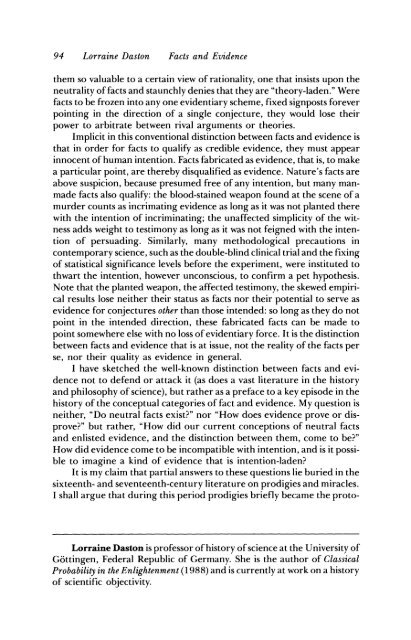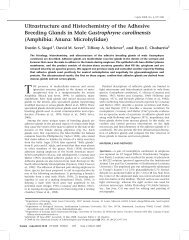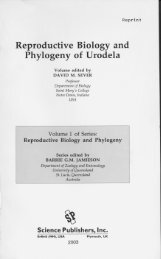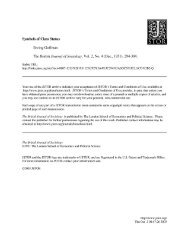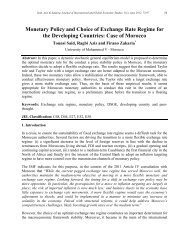Marvelous Facts and Miraculous Evidence in Early Modern Europe ...
Marvelous Facts and Miraculous Evidence in Early Modern Europe ...
Marvelous Facts and Miraculous Evidence in Early Modern Europe ...
You also want an ePaper? Increase the reach of your titles
YUMPU automatically turns print PDFs into web optimized ePapers that Google loves.
94 Lorra<strong>in</strong>e Daston<br />
<strong>Facts</strong> <strong>and</strong> <strong>Evidence</strong><br />
them so valuable to a certa<strong>in</strong> view of rationality, one that <strong>in</strong>sists upon the<br />
neutrality of facts <strong>and</strong> staunchly denies that they are "theory-laden." Were<br />
facts to be frozen <strong>in</strong>to any one evidentiary scheme, fixed signposts forever<br />
po<strong>in</strong>t<strong>in</strong>g <strong>in</strong> the direction of a s<strong>in</strong>gle conjecture, they would lose their<br />
power to arbitrate between rival arguments or theories.<br />
Implicit <strong>in</strong> this conventional dist<strong>in</strong>ction between facts <strong>and</strong> evidence is<br />
that <strong>in</strong> order for facts to qualify as credible evidence, they must appear<br />
<strong>in</strong>nocent of human <strong>in</strong>tention. <strong>Facts</strong> fabricated as evidence, that is, to make<br />
a particular po<strong>in</strong>t, are thereby disqualified as evidence. Nature's facts are<br />
above suspicion, because presumed free of any <strong>in</strong>tention, but many manmade<br />
facts also qualify: the blood-sta<strong>in</strong>ed weapon found at the scene of a<br />
murder counts as <strong>in</strong>crimat<strong>in</strong>g evidence as long as it was not planted there<br />
with the <strong>in</strong>tention of <strong>in</strong>crim<strong>in</strong>at<strong>in</strong>g; the unaffected simplicity of the witness<br />
adds weight to testimony as long as it was not feigned with the <strong>in</strong>tention<br />
of persuad<strong>in</strong>g. Similarly, many methodological precautions <strong>in</strong><br />
contemporary science, such as the double-bl<strong>in</strong>d cl<strong>in</strong>ical trial <strong>and</strong> the fix<strong>in</strong>g<br />
of statistical significance levels before the experiment, were <strong>in</strong>stituted to<br />
thwart the <strong>in</strong>tention, however unconscious, to confirm a pet hypothesis.<br />
Note that the planted weapon, the affected testimony, the skewed empirical<br />
results lose neither their status as facts nor their potential to serve as<br />
evidence for conjectures other than those <strong>in</strong>tended: so long as they do not<br />
po<strong>in</strong>t <strong>in</strong> the <strong>in</strong>tended direction, these fabricated facts can be made to<br />
po<strong>in</strong>t somewhere else with no loss of evidentiary force. It is the dist<strong>in</strong>ction<br />
between facts <strong>and</strong> evidence that is at issue, not the reality of the facts per<br />
se, nor their quality as evidence <strong>in</strong> general.<br />
I have sketched the well-known dist<strong>in</strong>ction between facts <strong>and</strong> evidence<br />
not to defend or attack it (as does a vast literature <strong>in</strong> the history<br />
<strong>and</strong> philosophy of science), but rather as a preface to a key episode <strong>in</strong> the<br />
history of the conceptual categories of fact <strong>and</strong> evidence. My question is<br />
neither, "Do neutral facts exist?" nor "How does evidence prove or disprove?"<br />
but rather, "How did our current conceptions of neutral facts<br />
<strong>and</strong> enlisted evidence, <strong>and</strong> the dist<strong>in</strong>ction between them, come to be?"<br />
How did evidence come to be <strong>in</strong>compatible with <strong>in</strong>tention, <strong>and</strong> is it possible<br />
to imag<strong>in</strong>e a k<strong>in</strong>d of evidence that is <strong>in</strong>tention-laden?<br />
It is my claim that partial answers to these questions lie buried <strong>in</strong> the<br />
sixteenth- <strong>and</strong> seventeenth-century literature on prodigies <strong>and</strong> miracles.<br />
I shall argue that dur<strong>in</strong>g this period prodigies briefly became the proto-<br />
Lorra<strong>in</strong>e Daston is professor of history of science at the University of<br />
Gott<strong>in</strong>gen, Federal Republic of Germany. She is the author of Classical<br />
Probability <strong>in</strong> the Enlightenment (1988) <strong>and</strong> is currently at work on a history<br />
of scientific objectivity.


